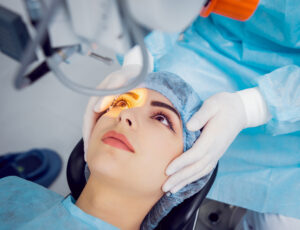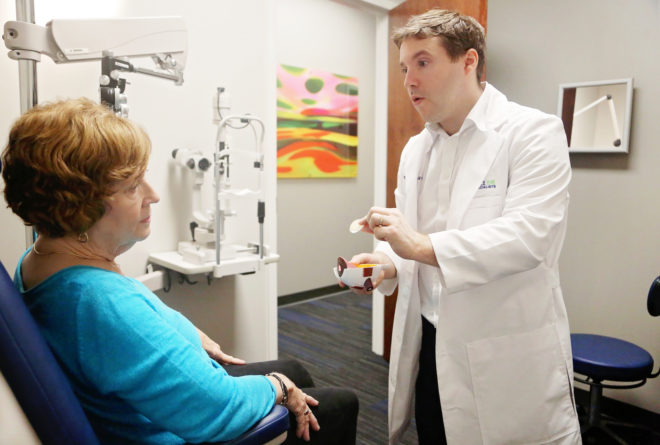The cornea is a vital component of our eyes, responsible for focusing light and allowing us to see clearly. However, certain vision conditions, such as nearsightedness, farsightedness, and astigmatism, can affect the cornea’s shape and compromise our visual acuity. Fortunately, advancements in medical technology have led to the development of LASIK, a surgical procedure that can correct these corneal irregularities and improve vision. In this article, we will explore the world of LASIK for cornea, its benefits, eligibility criteria, the procedure itself, postoperative care, potential risks, choosing the right surgeon, and address common questions.
Contents
Understanding Cornea

The cornea is the clear, dome-shaped outermost layer of the eye, acting as a protective barrier and helping to focus light onto the retina. Any abnormalities in the cornea’s curvature can cause refractive errors, leading to blurry vision. These conditions can be a hindrance to daily activities and significantly impact the quality of life. Thankfully, LASIK offers a solution to these vision problems.
What is LASIK?
LASIK, short for “Laser-Assisted in Situ Keratomileusis,” is a surgical procedure that uses precise laser technology to reshape the cornea. By reshaping the cornea’s curvature, LASIK aims to correct refractive errors, including nearsightedness, farsightedness, and astigmatism. This outpatient procedure has gained immense popularity due to its effectiveness, safety, and quick recovery time.
Advantages of LASIK for Cornea
LASIK offers several benefits for individuals struggling with corneal-related vision issues. Let’s explore some of the key advantages:
Improved Vision
Following LASIK surgery, many patients experience significantly improved vision, often achieving 20/20 or better visual acuity. The corneal reshaping allows light to properly focus on the retina, leading to clearer, sharper vision.
Reduced Dependence on Glasses and Contact Lenses
One of the main reasons people opt for LASIK is to reduce their reliance on glasses or contact lenses. After successful LASIK surgery, individuals often find that they no longer need to rely on corrective eyewear for their daily activities. This newfound freedom from glasses or contact lenses can greatly enhance convenience and self-confidence.
Quick and Painless Procedure
LASIK is a relatively quick and painless procedure. The entire process typically takes only around 15 minutes per eye, and the majority of patients experience minimal discomfort during the surgery. Local anesthesia is administered to numb the eyes, ensuring a pain-free experience.
Long-lasting Results
LASIK offers long-lasting vision correction. Once the cornea is reshaped through the procedure, the results are typically permanent. However, it’s important to note that age-related changes in vision, such as presbyopia, may still occur and may require additional interventions in the future.
Eligibility for LASIK

While LASIK can be a life-changing procedure for many individuals, not everyone is an ideal candidate. Eligibility for LASIK is determined through a comprehensive evaluation of various factors, with a primary focus on cornea health. Additionally, other considerations such as age, overall eye health, and stable vision are taken into account.
Evaluating Cornea Health
A thorough examination of the cornea is crucial to assess its health and suitability for LASIK. The thickness and shape of the cornea, the presence of any corneal diseases or abnormalities, and the stability of the corneal prescription are evaluated. These factors help determine the potential success and safety of the procedure.
Other Considerations
Apart from cornea health, other factors may impact LASIK eligibility. These include age (typically 18 years or older), stable vision for at least one year, absence of certain eye conditions or diseases, and overall good health. A comprehensive consultation with an experienced LASIK surgeon will help determine if LASIK is the right choice for an individual.
Preparing for LASIK Surgery
Before undergoing LASIK surgery, it’s important to prepare adequately to ensure a successful outcome. The preparation process typically involves the following steps:
Consultation and Examination
The initial step is to schedule a consultation with a reputable LASIK surgeon. During this consultation, the surgeon will assess the individual’s eye health, discuss their visual goals and expectations, and answer any questions or concerns.
Discussing Expectations and Risks
Open and honest communication between the patient and the surgeon is essential. The surgeon will explain the potential risks and complications associated with LASIK, as well as the expected outcomes based on the individual’s unique circumstances. This helps manage expectations and allows the patient to make an informed decision.
Preoperative Instructions
In the days leading up to the surgery, the surgeon will provide specific instructions to follow. These may include discontinuing the use of contact lenses for a certain period, avoiding the use of eye makeup, and abstaining from certain medications that could interfere with the surgery.
The LASIK Procedure

On the day of the LASIK procedure, the following steps are typically involved:
Anesthesia and Eye Preparation
Local anesthesia is administered to numb the eyes, ensuring comfort throughout the procedure. The surgeon will clean the eye area and use a specialized instrument to keep the eyelids open.
Corneal Reshaping
The surgeon will use a femtosecond laser or microkeratome to create a thin, hinged flap on the cornea. This flap is gently lifted, and an excimer laser is used to precisely reshape the underlying corneal tissue based on the individual’s unique prescription.
Recovery Time
After the LASIK procedure is completed, the corneal flap is repositioned, acting as a natural bandage. No stitches are required. The patient is then provided with protective eyewear and specific postoperative instructions. Most individuals experience improved vision within 24 to 48 hours and can resume normal activities within a few days.
Postoperative Care
Proper postoperative care is crucial for a smooth recovery and optimal results. The following guidelines are typically recommended:
Medications and Follow-up Visits
The surgeon will prescribe eye drops or medications to prevent infection, reduce inflammation, and promote healing. It is important to diligently follow the prescribed medication schedule. Additionally, the patient will be scheduled for follow-up visits to monitor the healing process and ensure the eyes are responding well to the procedure.
Tips for a Smooth Recovery
During the recovery period, it is important to take certain precautions to aid in the healing process:
- Avoid rubbing the eyes, as this can disrupt the healing flap.
- Protect the eyes from bright sunlight and dust by wearing sunglasses.
- Avoid strenuous activities, swimming, and contact sports as advised by the surgeon.
- Use artificial tears to alleviate any temporary dryness or discomfort.
Potential Risks and Complications
While LASIK is generally considered safe and effective, like any surgical procedure, it carries certain risks and potential complications. These may include dry eyes, temporary visual disturbances such as glare or halos, overcorrection or under-correction, infection, and in rare cases, corneal flap complications. It is important to discuss these risks thoroughly with the surgeon during the consultation phase.
Choosing the Right LASIK Surgeon

Selecting a qualified and experienced LASIK surgeon is paramount to ensure a successful outcome. Consider the following factors when choosing a surgeon:
Experience and Qualifications
Research the surgeon’s credentials, including their education, training, certifications, and years of experience performing LASIK procedures. Look for a surgeon who specializes in corneal refractive surgery.
Technology and Facilities
Opt for a surgeon who utilizes advanced LASIK technology and has access to state-of-the-art facilities. Modern equipment and techniques contribute to better surgical precision and outcomes.
Patient Testimonials and Reviews
Read reviews and testimonials from previous LASIK patients to get insights into their experiences with the surgeon and their overall satisfaction with the results. Personal recommendations can also be valuable in the decision-making process.
Conclusion
LASIK for the cornea is a transformative procedure that can significantly improve vision and liberate individuals from the limitations of glasses or contact lenses. By reshaping the cornea with precision and utilizing advanced laser technology, LASIK offers numerous advantages, including improved vision, reduced dependence on corrective eyewear, a quick and painless procedure, and long-lasting results. However, eligibility for LASIK depends on various factors, including cornea health and overall eye health.
While LASIK is generally safe, potential risks and complications exist, and it’s essential to choose a qualified LASIK surgeon. Considering factors like experience, qualifications, technology, and patient testimonials can help in making an informed decision.
LASIK eye surgery is a safe 10-minute procedure to help you get rid of glasses. EyeMantra offers the most advanced LASIK options including PRK, Femto Lasik, SMILE surgery, Standard LASIK, ICL, and Contoura vision. If you have any questions on Lasik surgery in Delhi, Lasik surgery cost, and Lasik procedure, call us at 9711116605 or email at [email protected].


